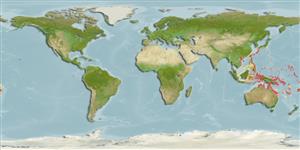>
Gobiiformes (Gobies) >
Gobiidae (Gobies) > Gobionellinae
Etymology: Redigobius: Latin,. Redere = to come back + Latin, gobius = gudgeon.
More on author: Herre.
Environment: milieu / climate zone / depth range / distribution range
Ecologia
marinhas; Água doce; estuarina bentopelágico; dH range: ? - 8; anfídromo (Ref. 59012); intervalo de profundidade 0 - 5 m (Ref. 86942). Tropical; 25°C - 28°C (Ref. 2060)
Asia: Sri Lanka, Philippines, Malaysia and Indonesia (Ref. 13235); Japan (Ref.43239). Oceania: New Guinea. Reported from New Caledonia (Ref. 13235), Micronesia (Ref. 59012). Africa: Mozambique. Indian Ocean: Madagascar, Mayotte (Ref. 55749).
Tamanho / Peso / Idade
Maturity: Lm ? range ? - ? cm
Max length : 3.8 cm SL macho/indeterminado; (Ref. 44894)
Descrição breve
Chaves de identificação | Morfologia | Morfometria
Espinhos dorsais (total) : 7; Raios dorsais moles (total) : 6 - 7; Espinhos anais: 1; Raios anais moles: 6. Distinguished by the following characteristics: moderate-sized Redigobius; single black band extending down and back from tip of first dorsal fin; distinct black band extending from eye diagonally across opercle to lower edge of pectoral fin base; first dorsal fin tall and elongate, third or fourth spine longest; opercle with small ctenoid scales; 14 circumpeduncular scales; second dorsal rays modally I,7; anal rays I,6; pectoral rays 16-17; longitudinal scales 23-25; TRB 9-11; predorsal scales 9-12 (Ref. 84480).
Adults inhabit coastal estuaries, lakes (Ref. 48637), and entering lower reaches of freshwater streams (Ref. 44894). Also found in quiet mangrove estuarine habitats (Ref. 84480). Also Ref. 43716.
Life cycle and mating behavior
Maturities | Reprodução | Spawnings | Egg(s) | Fecundities | Larvas
Keith, P., G. Marquet, P. Valade, P. Bosc and E. Vigneux, 2006. Atlas des poissons et des crustacés d'eau douce des Comores, Mascareignes et Seychelles. Muséum national d’Histoire naturelle, Paris. Patrimoines naturels, 65:250p. (Ref. 57749)
Categoria na Lista Vermelha da IUCN (Ref. 130435)
Ameaça para o homem
Harmless
Utilização humana
Ferramentas
Relatórios especiais
Descarregue XML
Fontes da internet
Estimates based on models
Preferred temperature (Ref.
123201): 25.4 - 29.3, mean 28.6 °C (based on 1307 cells).
Phylogenetic diversity index (Ref.
82804): PD
50 = 0.5000 [Uniqueness, from 0.5 = low to 2.0 = high].
Bayesian length-weight: a=0.00977 (0.00442 - 0.02163), b=3.05 (2.86 - 3.24), in cm total length, based on LWR estimates for this (Sub)family-body shape (Ref.
93245).
Nível Trófico (Ref.
69278): 3.3 ±0.4 se; based on size and trophs of closest relatives
Resiliência (Ref.
120179): Elevada, tempo mínimo de duplicação da população menor que 15 meses (Preliminary K or Fecundity.).
Fishing Vulnerability (Ref.
59153): Low vulnerability (10 of 100).
